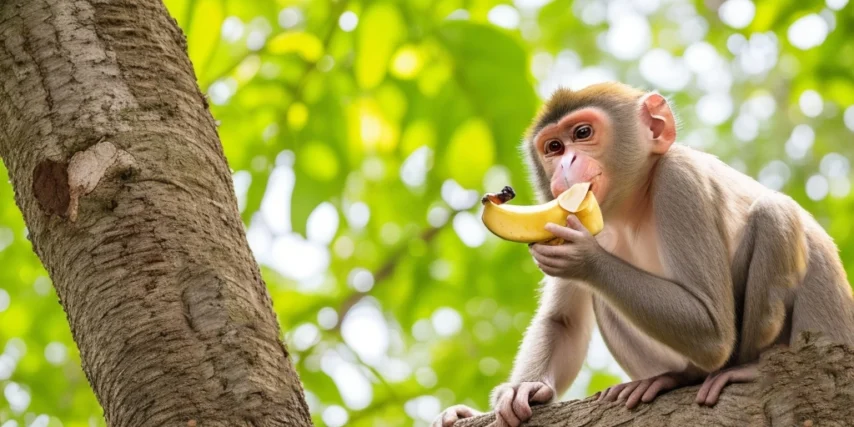Unraveling the Myth: Why Do Monkeys Love Bananas So Much?
Bananas and monkeys: an iconic duo immortalized in cartoons, movies, and popular culture. The sight of a monkey gleefully peeling a banana is a timeless image, but what lies beneath this seemingly innate preference? Is there a scientific explanation for why monkeys have a penchant for this tropical fruit? In this article, we delve deep into the realms of biology, evolution, and cultural influence to unravel the mystery behind why monkeys love bananas so much.
The Evolutionary Connection:
To understand the affinity between monkeys and bananas, we must first explore their evolutionary relationship. Monkeys, like humans, are primates with a shared ancestry that stretches back millions of years. Our primate ancestors resided in lush, tropical forests where fruits were abundant. Over time, primates developed a taste for sweet, energy-rich fruits as a vital component of their diet.

Bananas, with their convenient packaging and high sugar content, became a favored food source for primates, including monkeys. Their availability year-round in tropical regions ensured a consistent food supply, contributing to the development of a preference for bananas among primates.
Nutritional Benefits:
Beyond taste preference, bananas offer a plethora of nutritional benefits that make them an ideal dietary choice for monkeys. Bananas are rich in carbohydrates, providing a quick source of energy essential for the active lifestyles of primates. Moreover, they contain essential vitamins and minerals, including potassium, vitamin C, and vitamin B6, which support overall health and well-being.
The soft texture and easy digestibility of bananas further enhance their appeal to monkeys, especially young and elderly individuals who may have difficulty consuming tougher foods. Additionally, the presence of dietary fiber aids in digestion and promotes gut health, ensuring optimal nutrient absorption.
Cultural Influence:
While the biological predisposition of monkeys to favor bananas is undeniable, the cultural influence cannot be overlooked. Human interaction with monkeys, whether in captivity or in the wild, has played a significant role in reinforcing the association between monkeys and bananas.
In many zoos and wildlife parks, bananas are commonly used as treats to reward monkeys for desired behaviors or as a means of enticing them to approach closer for observation or interaction. This practice not only reinforces the monkeys’ preference for bananas but also perpetuates the stereotype in the public consciousness.
Furthermore, the portrayal of monkeys consuming bananas in popular media, such as cartoons and advertisements, has further cemented the association between the two. This cultural reinforcement serves to perpetuate the notion that bananas are the quintessential food for monkeys, despite the diversity of their natural diet.

Behavioral Adaptations:
In addition to their nutritional value, bananas offer practical benefits for monkeys in their natural habitat. The ease of consumption and minimal preparation required make bananas a convenient food choice for monkeys on the go. Their soft texture and high moisture content also help prevent dehydration, especially in hot and humid climates.
Monkeys have developed various adaptations to exploit banana resources efficiently. Some species, such as capuchin monkeys, have dexterous hands capable of peeling bananas with precision, while others may use tools or employ cooperative behaviors to access hard-to-reach fruits.
Environmental Impact:
While the relationship between monkeys and bananas may seem harmonious, it is not without its challenges, particularly concerning human intervention and habitat destruction. The expansion of agriculture, including banana plantations, has encroached upon the natural habitats of monkeys, leading to habitat fragmentation and loss.

Furthermore, the reliance of monkeys on cultivated bananas in human-dominated landscapes can lead to conflicts, as they may raid crops in search of food. Balancing the needs of both humans and monkeys requires proactive conservation efforts aimed at preserving biodiversity and mitigating human-wildlife conflicts.
The love affair between monkeys and bananas transcends mere preference, encompassing biological, cultural, and behavioral factors. From their shared evolutionary history to the nutritional benefits they offer, bananas hold a special place in the hearts (and stomachs) of monkeys worldwide.
However, it is essential to recognize the broader implications of this relationship, including the environmental impact of banana cultivation and the need for conservation efforts to protect both monkeys and their habitats. By understanding the multifaceted nature of the connection between monkeys and bananas, we gain insight into the complex interplay between humans, wildlife, and the natural world.







